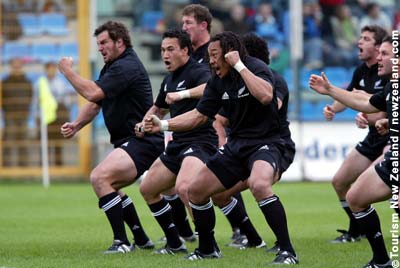
No other international sporting team possesses a pre-match ritual as powerful as the famed All Black haka.
From the more traditional Ka mate, Ka mate – first performed before an international rugby fixture by the New Zealand Native Team in 1888 – to the recently composed Kapa o Pango, the haka plays an integral role in physically and mentally preparing All Black teams for battle.
Māori haka
The haka is an ancient posture dance of the New Zealand Māori that was traditionally used to prepare a war party for battle. It was performed either on the battle field prior to engagement with the enemy, or as the war party was leaving their own village en route to a battle. The ferocious nature of the haka created a united frenzy among the war party preparing them mentally and physically for the reality of war and impending conflict.
‘Ka mate, Ka mate’
Ka mate, Ka mate – the original All Black haka – was composed in the early 19th century by famous Māori warrior chief Te Rauparaha, of the Ngāti Toa Rangatira tribe.
Te Rauparaha was fleeing an enemy tribe seeking retribution for a past wrong he had committed against them. As he was chased across the central plateau of the North Island, fellow chief Te Wharerangi helped him hide in a pit and then instructed his wife Te Rangikoaea to sit on the pit entrance.
After the enemy had moved on, Te Rauparaha emerged from the pit. There, in jubilant celebration of his lucky escape and in front of Te Wharerangi and his people, he performed Ka mate, Ka mate which he had composed while deep in the pit.
‘Kapa o Pango’
Ka mate, Ka mate was the only haka performed by the All Blacks until 2005 when a new haka – Kapa o Pango – was unveiled before a match against South Africa at Carisbrook Stadium, in Dunedin.
Kapa o Pango – written for the All Blacks by Derek Llardelli, an expert haka composer from the Ngati Porou tribe – roughly translates as ‘All Blacks’, and the haka also makes reference to the silver fern, another Kiwi sporting icon.
The All Blacks won the match against the Springboks 31 – 27, but the new haka prompted criticism because the closing action was misinterpreted by many as a distasteful, throat slitting gesture.
Llardelli , in defence of his composition, was quick to explain that the concluding movement was actually a Māori symbol of drawing vital energy into the body that fitted the spirit of the haka.
Haka performance
The decision on who leads the haka or which haka is performed before an All Black test is usually made by the team before the game. All Black management say it depends on how the team is feeling, and who their opponents are.
A common misconception is that haka should only be performed by males. While this is certainly true for many haka, there are some haka that can be performed by anyone, regardless of sex. There are even some women-only haka.
More about: Kapa haka – traditional Māori performances
Resources
Website All Black: http://www.allblacks.com/

